Coastal barriers, shoreline upgrades among proposed moves to shield southeast Singapore against rising seas
The proposed coastal protection measures will complement the previously announced Long Island at East Coast to provide a continuous line of defence, said national water agency PUB.
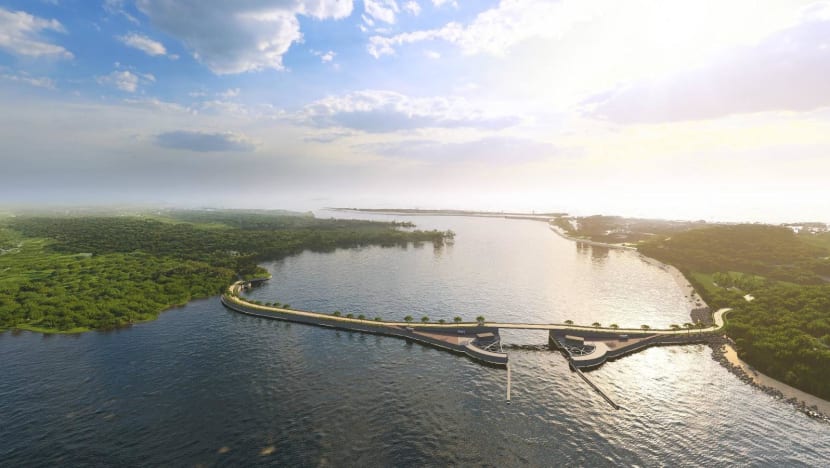
An artist's impression of an open coastal barrier at the Greater Southern Waterfront. (Image: National water agency PUB)

This audio is generated by an AI tool.
SINGAPORE: To protect the low-lying areas in Changi and the Greater Southern Waterfront from flooding, a study has proposed building coastal protection structures to form a “continuous line of defence”, with construction set to begin in the 2030s, national water agency PUB said on Saturday (Aug 30).
These include three coastal barriers linking Sentosa, Pulau Brani and the mainland, retrofits to the Marina Barrage and raised coastal protection structures, among other measures.
Setback measures, which refer to coastal protection structures built further inland, will also be used at Changi Beach Park so as to preserve beach access and minimise impact on biodiversity.
The coastal protection site-specific study for the City-East Coast region started in 2021 and cost S$18 million (US$14 million). The region includes the Greater Southern Waterfront, East Coast and Changi.
PUB, along with relevant government agencies, will next look into detailed studies to develop engineering designs of the recommended measures and conduct environmental impact assessments, the agency said.
Construction of coastal protection measures is slated to begin in the 2030s.
The recommendations for the Greater Southern Waterfront and Changi complement other coastal protection efforts at East Coast, providing a continuous line of defence to protect the area against rising sea levels, PUB said.
This would include the “Long Island” that was announced in 2023, which would create an enclosed waterbody in front of East Coast Park and would also serve as a barricade against erosion in the mainland.
Speaking at the launch of the Coastal Protection Exhibition on Saturday at VivoCity, Deputy Prime Minister and Minister for Trade and Industry Gan Kim Yong said that unlike larger countries, Singapore does not have the option of "retreating" inland.
"Protecting our coastlines is therefore of existential importance," said Mr Gan, adding that coastal protection is a complex task that will take decades to complete.
"But we can take heart in our unique ability to plan far ahead ... Coastal protection is another such endeavour that will require sustained efforts over generations – and just as with our public housing, water and infrastructure, it is a necessary investment in the safety, security and resilience of our nation."
The need for coastal protection
At this year’s Budget, Prime Minister Lawrence Wong announced that an additional S$5 billion will be injected into the Coastal and Flood Protection Fund. The fund was announced in 2020 with an initial fund of S$5 billion to protect Singapore against rising sea levels.
As a low-lying country, about a third of Singapore’s land is less than five metres above mean sea level.
Studies from the Centre for Climate Research Singapore and the third National Climate Change Study projected that Singapore could see a permanent mean sea level rise of up to 1.15 metres by 2100.
This means that low-lying areas of the country will be vulnerable to the effects of permanent mean sea level rise, tides and storm surges.
If no action is taken, widespread flooding could happen in the City-East Coast region during extreme coastal storm surges in 2050.
PROTECTING THE GREATER SOUTHERN WATERFRONT
The Greater Southern Waterfront region is set to become a mixed-use waterfront precinct with leisure and tourism developments, said Mr Gan.
The area stretches from Pasir Panjang Ferry Terminal to Marina East, and includes Sentosa and Pulau Brani, which will be developed into a tourism destination as part of the Greater Sentosa Master Plan.
From the study, three coastal barriers and shoreline measures are recommended.
Two coastal barriers will link eastern Sentosa to Pulau Brani and then to mainland Singapore, based on a map provided by PUB. The third barrier will connect western Sentosa to mainland Singapore, although the exact location has yet to be determined.
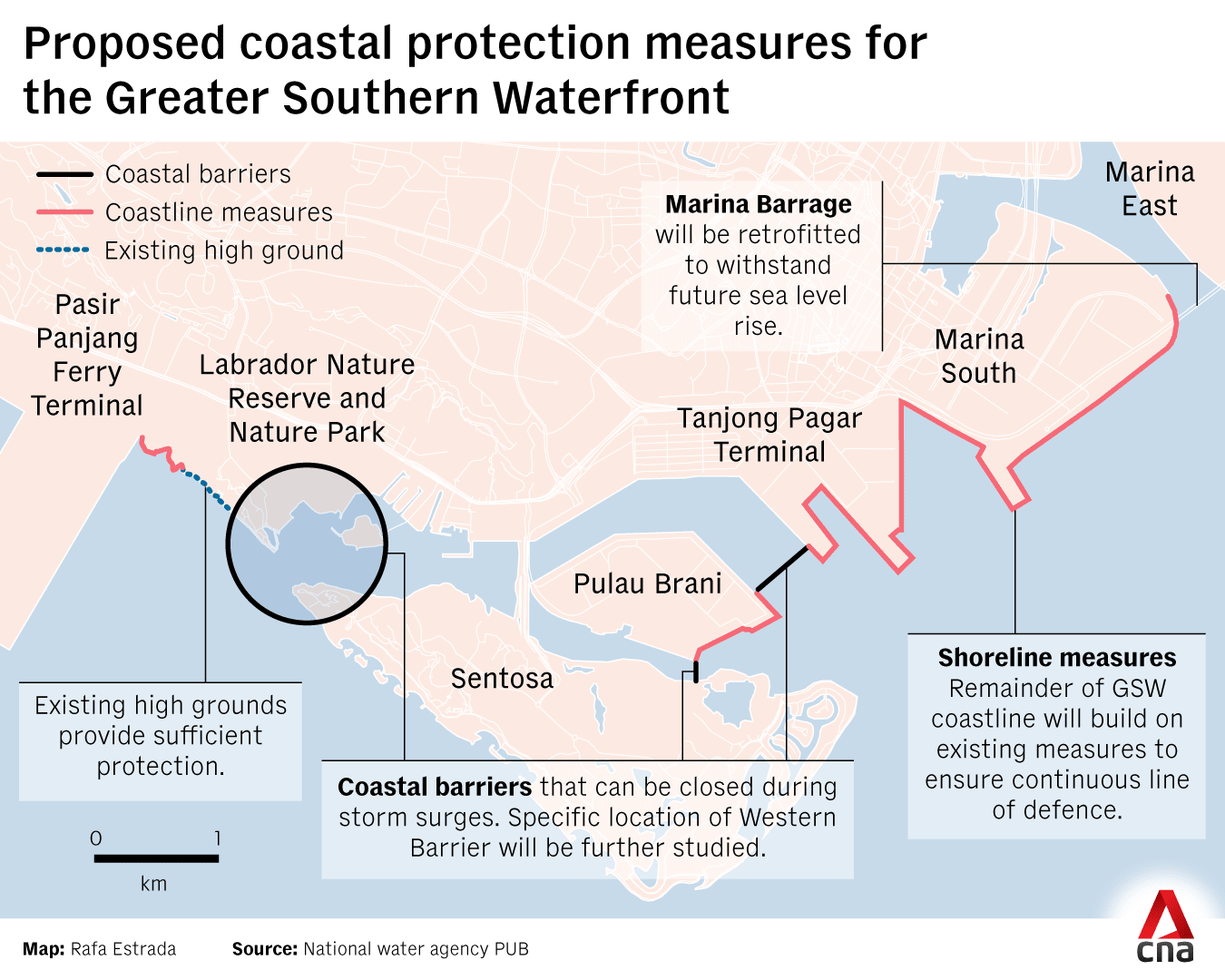
These coastal barriers comprise a series of gates that remain open by default to minimise environmental impact and allow maritime activities to take place. During high tides and storm surges, the gates will close to protect the area against coastal flooding.
Similar barriers can be found in other countries, such as the Thames Barrier in the United Kingdom and the Maeslant Barrier in the Netherlands.
PUB had considered the alternative approach of raising seawalls, or vertical barriers built of concrete and rocks, and constructing tidal gates along the waterfront promenade.
A tidal gate is typically placed across a water channel, such as a canal or a large outlet drain. It consists of barriers that can be lifted or lowered to control the flow of water.
However, such an approach would block sea views and would require more land, PUB said.
As part of its study, the agency had considered feedback from stakeholders, including experts, nature groups and youth about preserving direct access to the sea and waterfront promenade.
Mr Gan said the construction of coastal barriers will allow the public to still have access to the coastline and enjoy the sea view, which was highlighted by several participants during these feedback sessions.
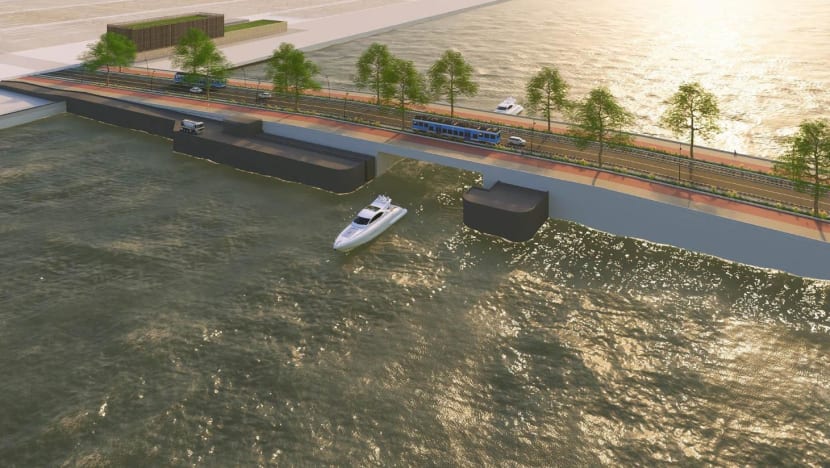
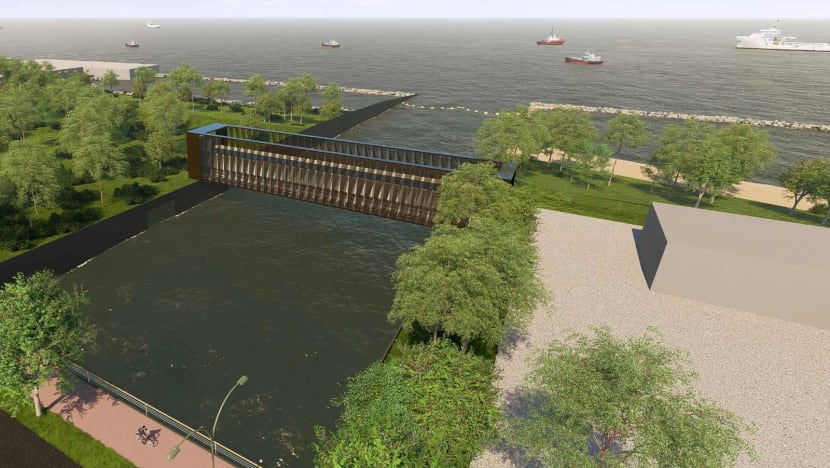
Meanwhile, existing coastal protection along Pasir Panjang Ferry Terminal to Labrador Nature Park, and from Marina South to Marina East will be upgraded, PUB said.
This includes raising existing sloped protective structures built along shorelines, known as revetments, at Marina South.
The Marina Barrage will also be retrofitted to guard against rising sea levels.
A MIX OF MEASURES IN CHANGI
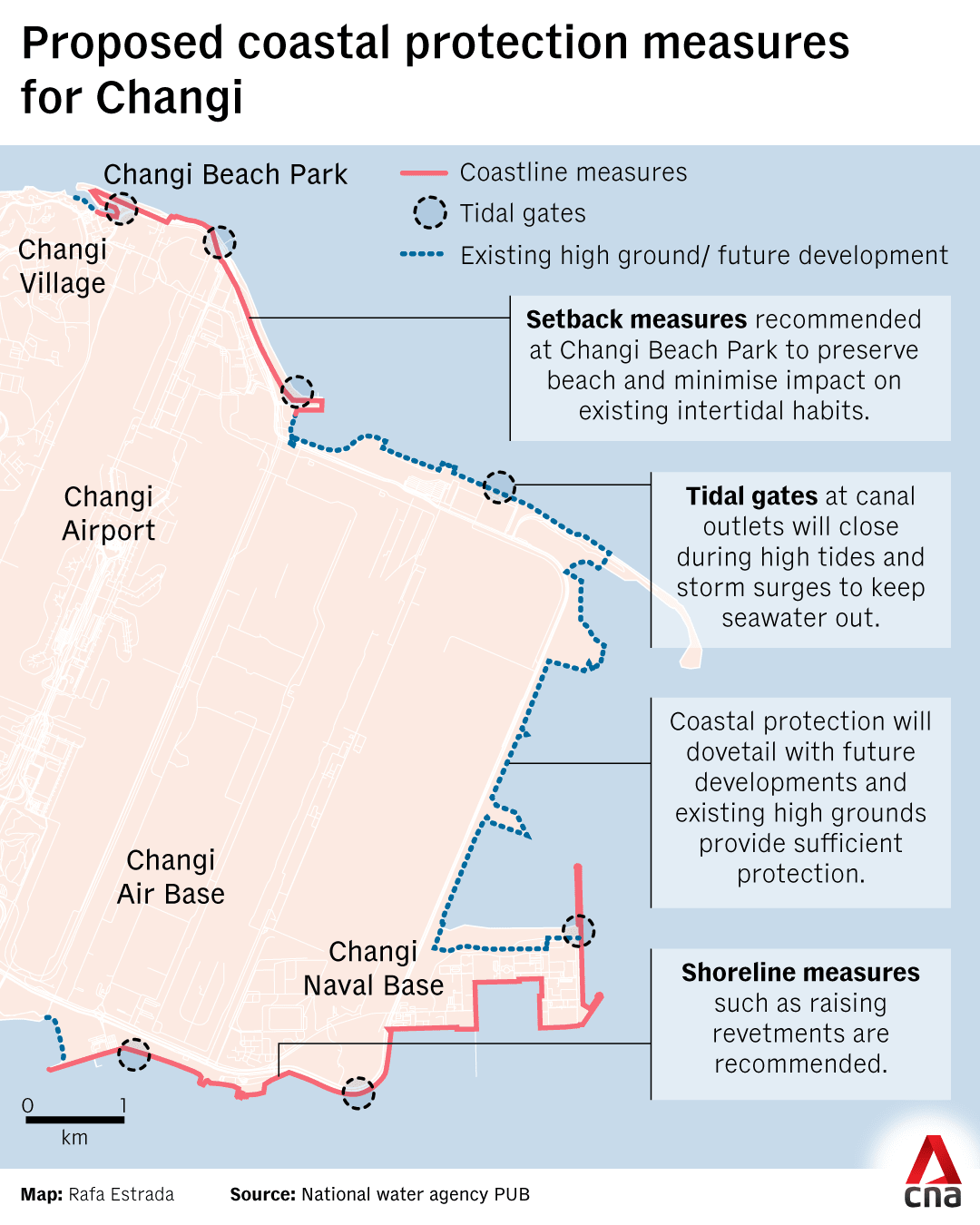
As for Changi’s coastline, PUB said the study recommended a mix of revetments, tidal gates and bunds as protection measures. A bund is a raised coastal defence structure made from compacted soil, clay or sand.
The Changi region encompasses Changi Village, Changi Beach Park, Changi Airport, Changi Naval Base and other industrial and aviation facilities.
Changi Beach Park could see raised bunds, which can double up as footpaths or cycling tracks.
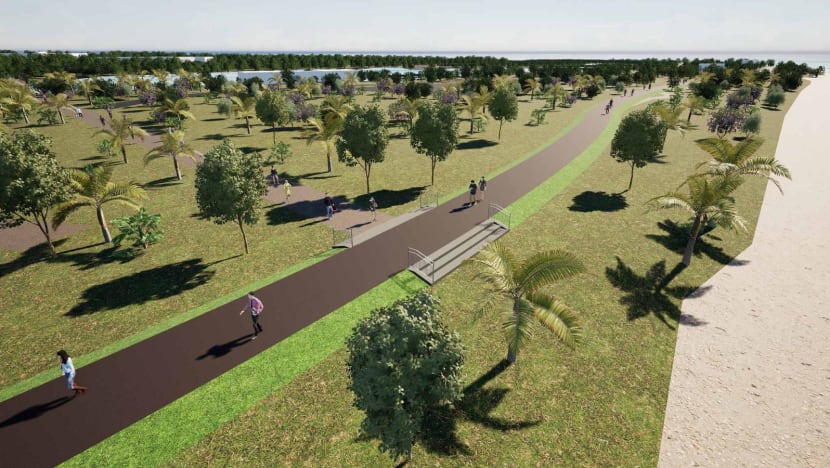
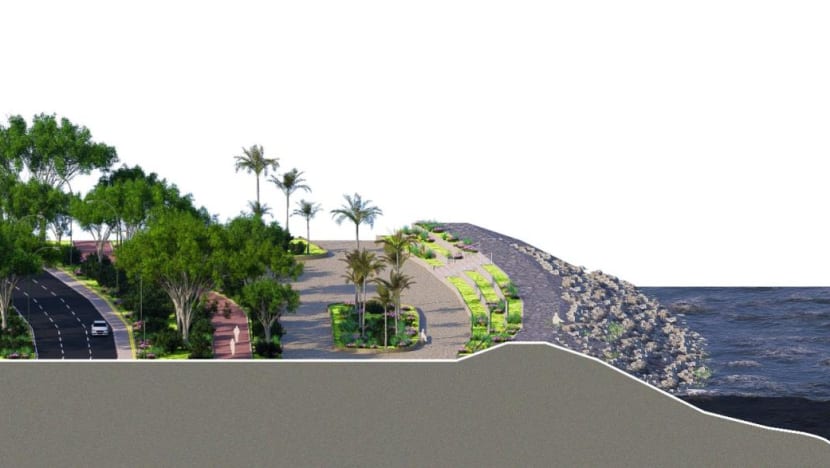
To preserve recreational access to Changi Beach Park, these bunds will be positioned further inland.
Doing so will not only maintain beach access, it will also serve to minimise impact to existing intertidal habitats, PUB said.
Additionally, there are plans to install tidal gates at locations where existing major canals discharge to the sea. PUB said that the location and design of such gates will need to be further studied so they integrate with the landscape.
PUB will also carry out measures at the shoreline. At Changi South, existing revetments and seawalls may be raised, with the potential of incorporating design features to add recreational value to the area, PUB said.
Ms Hazel Khoo, director of the Coastal Protection Department at PUB, said that Singapore's coastal protection requires "innovative solutions" that go beyond traditional approaches.
"Coastal protection requires long-term and careful planning, and trade-offs are inevitable. There are still coastlines with unique characteristics that we will need to conduct site-specific studies progressively," she said, adding that PUB will explore solutions that balance diverse priorities.
Site-specific studies at other regions of Singapore’s coastline are ongoing or will commence soon, PUB said. They include site-specific studies at Sentosa Island and the southwestern coast, which are slated to commence in 2026.
The Ministry of Sustainability and Environment and PUB will also introduce a Coastal Protection Bill next year, to enforce compliance with coastal protection standards and spell out the responsibilities of stakeholders involved.
PUB will also launch a code of practice for coastal protection by the first half of 2026 to set standards for the design, construction and operation of coastal protection structures in Singapore.
















